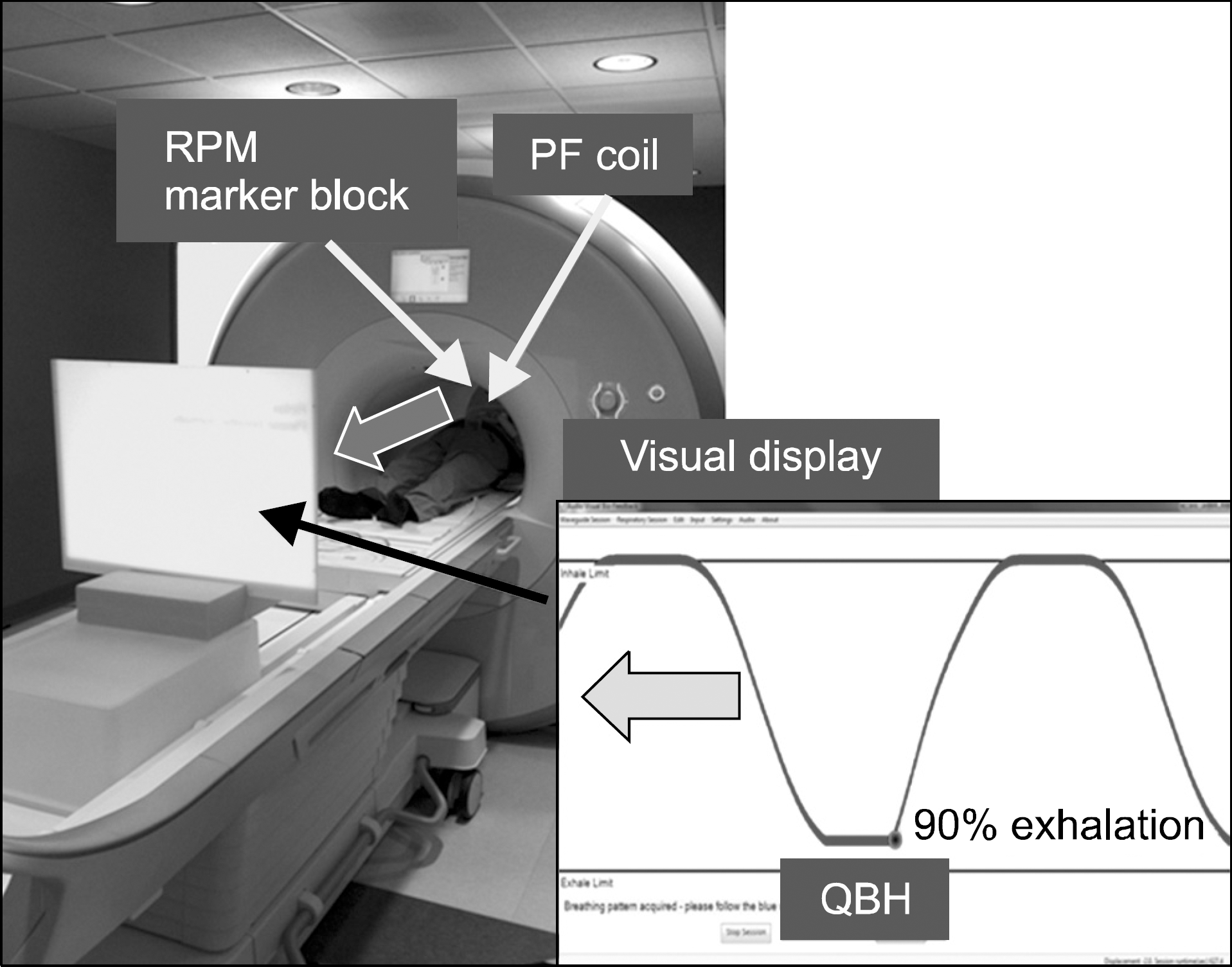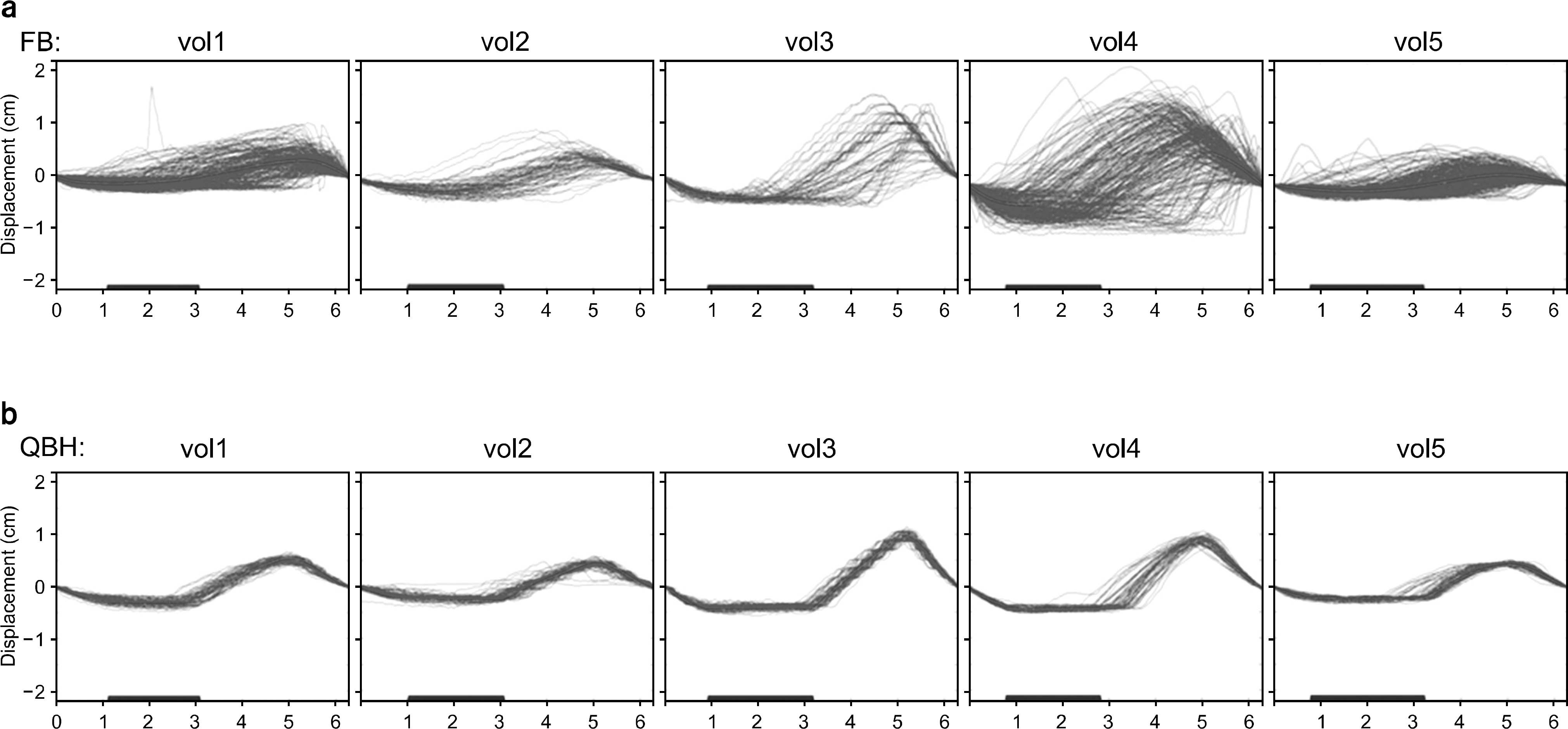Abstract
The aim of the study is to test a hypothesis that quasi-breath-hold (QBH) biofeedback improves the residual respiratory motion management in gated 3D thoracic MR imaging, reducing respiratory motion artifacts with insignificant acquisition time alteration. To test the hypothesis five healthy human subjects underwent two gated MR imaging studies based on a T2 weighted SPACE MR pulse sequence using a respiratory navigator of a 3T Siemens MRI: one under free breathing and the other under QBH biofeedback breathing. The QBH biofeedback system utilized the external marker position on the abdomen obtained with an RPM system (Real-time Position Management, Varian) to audio-visually guide a human subject for 2s breath-hold at 90% exhalation position in each respiratory cycle. The improvement in the upper liver breath-hold motion reproducibility within the gating window using the QBH biofeedback system has been assessed for a group of volunteers. We assessed the residual respiratory motion management within the gating window and respiratory motion artifacts in 3D thoracic MRI both with/without QBH biofeedback. In addition, the RMSE (root mean square error) of abdominal displacement has been investigated. The QBH biofeedback reduced the residual upper liver motion within the gating window during MR acquisitions (∼6 minutes) compared to that for free breathing, resulting in the reduction of respiratory motion artifacts in lung and liver of gated 3D thoracic MR images. The abdominal motion reduction in the gated window was consistent with the residual motion reduction of the diaphragm with QBH biofeedback. Consequently, average RMSE (root mean square error) of abdominal displacement obtained from the RPM has been also reduced from 2.0 mm of free breathing to 0.7 mm of QBH biofeedback breathing over the entire cycle (67% reduction, p-value=0.02) and from 1.7 mm of free breathing to 0.7 mm of QBH biofeedback breathing in the gated window (58% reduction, p-value=0.14). The average baseline drift obtained using a linear fit was reduced from 5.5 mm/min with free breathing to 0.6 mm/min (89% reduction, p-value=0.017) with QBH biofeedback. The study demonstrated that the QBH biofeedback improved the upper liver breath-hold motion reproducibility during the gated 3D thoracic MR imaging. This system can provide clinically applicable motion management of the internal anatomy for gated medical imaging as well as gated radiotherapy.
Go to : 
References
1. Yamamoto T, Langner U, Loo Jr BW, Shen J, Keall PJ. Retrospective a na l ysi s of artifacts in four-dime nsional CT Images of 50 abdominal and thoracic r ad i othe rap y patients. International Journal of Ra diation Oncology∗Biology∗Physics. 72(4):1250–1258. 2008.
2. Langner UW, Keall PJ. Quantification of artifact re duction with real-time cine four-dimensional computed tomography ac – quisition me thods. International Journal of Ra diation Onc ology∗ Biology∗Physics. 76(4):1242–1250. 2010.
3. Yang J, Yamamoto T, Cho B, Seo Y, Keall PJ. The impact of audio-visual biofeedbac k on 4D PET images: results of a phantom study. Medica l Physics. 39(2):1046–1057. 2012.
4. Hugo GD, Campbell J, Zhang T, Di Yan DS. Cumulative lung dose for several motion management strategies as a function of pre-treatment patient parameters. Int J Radiat Oncol Biol Phys. 74:593–601. 2009.

5. Theuws J, Kwa SLS, Wagenaar AC, et al. Prediction of overall pulmonary function loss in relation to the 3-D dose distribution for patients with br east c an ce r a nd maligna nt lymphoma. Ra diother apy and Onc ology. 49(3):233–243. 1998.
6. Marks LB, Bentzen SM, Deasy JO, et al. Radiation dose-volume effects in the lung. International Journal of Radiation Oncology∗Biology∗Physics. 76(3):S70–S76. 2010.

7. Lim S, Park SH, Ahn SD, et al. Guiding c ur v e b ase d on the nor mal breathing as monitore d by thermocouple for r eg ul a r breathing. Me dic al Physics. 34(11):4514–4518. 2007.
8. Wang Y, Christy PS, Korosec FR, et al. Coronary M RI with a resp irator y fe edback monitor: the 2D imaging c as e. Magnetic Re sona nc e in Medic ine. 33(1):116–121. 1995.
9. Venkat RB, Sawant A, Suh Y, George R, Keall PJ. Development a nd preliminary eva luation of a prototype audiovisual biofeedb ac k device incorporating a patie nt-specific guiding wa veform. Physics in Medic ine and Biology. 53(11):N197. 2008.
10. George R, Chung TD, Vedam SS, et al. Audiovisual biofeedback for respiratory-gated radiotherapy: Impact of audio instruction and audio-visual biofeedb ac k on resp irator y-gated radiotherapy. Int J Radiat Onc ol Biol Phys. 65(3):924–933. 2006.
11. Locklin JK, Yanof J, Luk A, Varro Z, Patriciu A, Wood BJ. Respiratory biofeedback during CT-guided procedures. Journal of Vascular and Interventional Radiology. 18(6):749–755. 2007.

12. Kini VR, Vedam SS, Keall PJ, Patil S, Chen C, Mohan R. Patient training in resp irator y-gated ra diother apy. Medic al Dosimetry. 28(1):7–11. 2003.
13. Arnold JFT, Mörchel P, Glaser E, Pracht ED, Jakob PM. Lung MRI using an MR-compatible active breathing control (MR-ABC). M ag ne t i c Resonance in Medic ine. 58(6):1092–1098. 2007.

14. Keall P, Mageras G, Balter J, et al. The management of respiratory motion in radiation oncology rep ort of A AP M Ta sk Group 76. Me d Phys. 33:3874–3900. 2006.
15. Berbeco RI, Nishioka S, Shirato H, Chen GT, Jiang SB. Residual motion of lung tumours in gated radiotherapy with external respiratory surrogates. Physics in Medicine and Biology. 50(16):3655. 2005.

16. Park YK, Kim S, Kim H, Kim IIH, Lee K, Ye SJ. Quasi-breath-hold tec hnique using personalized audio-visual biofeedback for re spira tory motion management in r ad i othe rap y. Medical Physics 38: 3114 (. 2011.
17. Kim T, Pollock S, Lee D, O'Brien R, Keall P. Audiovisual biofeedback improves dia phragm motion re producibility in MR I. Medical Physics 39: 6921 (. 2012.
18. McRobbie DW, Moore EA, Graves MJ, Prince MR. MRI from Picture to Pr oton Camb ridge Univer sity Pr ess. 2006.
Go to : 
 | Fig. 1.QBH biofeedback system in 3 Tesla Siemens MRI consisting of the RPM system and audio-visual devices. The screen of the QBH biofeedback system shows a guiding wave (blue curve) and a marker position (red ball) in real time. 2s breath-hold at 90% exhalation position in respiratory cycle is shown. |
 | Fig. 2.Upper liver breath-hold motion obtained using the RF navigator pre-pulse with (a) FB and (b) QBH biofeedback breathing. The upper liver breath-hold motion reproducibility has been considerably improved at 90% exhalation using QBH biofeedback (arrow in (b)). Dark vertical lines indicate signal acquisition for MR images with a pause of the navigator. |
 | Fig. 3.Gated T2 weighted 3D thoracic MR images obtained with (a) FB and (b) QBH biofeedback breathing. Respiratory-related motion artifacts are shown distinctly in liver and lungs with free breathing [arrows in (a)]. The artifacts have been reduced by controlling residual motions within the gating window during acquisitions using QBH biofeedback [arrows in (b)]. |
 | Fig. 4.Example of RMSE analysis in displacement with (a) FB and (b) QBH biofeedback. Average RMSE of abdominal displacement has been reduced from 1.7 mm of free breathing to 0.7 mm of QBH biofeedback within the gating window (bar on the bottom of each figure), providing more consistent breathing patterns. |




 PDF
PDF ePub
ePub Citation
Citation Print
Print


 XML Download
XML Download